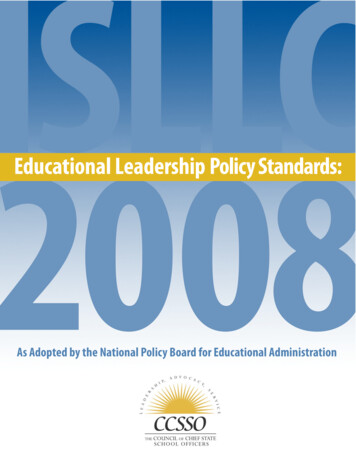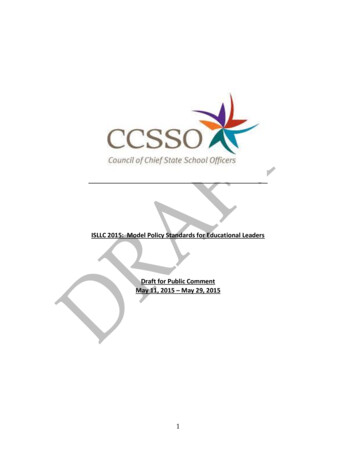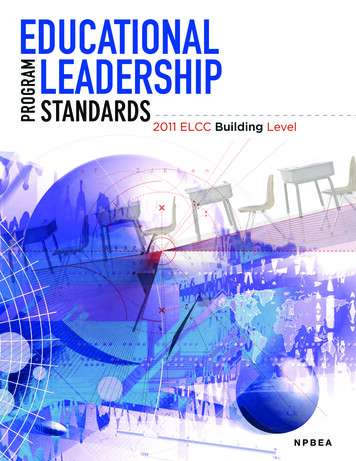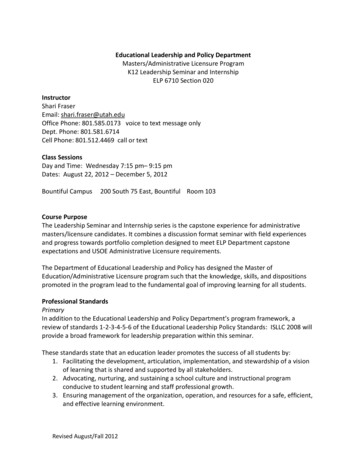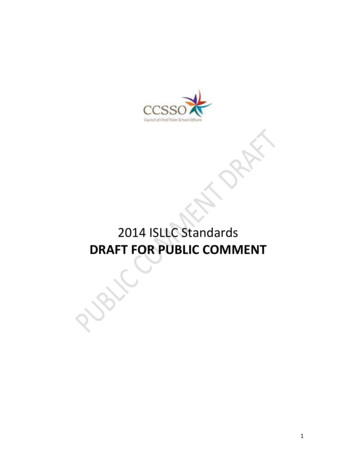
Transcription
2014 ISLLC StandardsDRAFT FOR PUBLIC COMMENT1
PUBLIC COMMENT DRAFT – 2014 ISLLC STANDARDS REFRESHThe Council of Chief State School Officers is a nonpartisan, nationwide,nonprofit organization of public officials who head departments of elementaryand secondary education in the states, the District of Columbia, the Departmentof Defense Education Activity, and five U.S. extra-state jurisdictions. CCSSOprovides leadership, advocacy, and technical assistance on major educationalissues. The Council seeks member consensus on major educational issues andexpresses their views to civic and professional organizations, federal agencies,Congress, and the public.Council of Chief State School OfficersOne Massachusetts Avenue, NW, Suite 700 Washington, DC 20001-1431Phone: 202-336-7000Fax: 202-408-1938Suggested Citation:Council of Chief State School Officers. (2014, XX). 2014 ISLLC Standards, Washington, DC:Author.Copyright 2014 by the Council of Chief State School Officers, Washington, DC.2
ContentsAcknowledgments. 4Introduction: Focusing on Instructional Leadership . 6Using the 2014 ISLLC Standards . 8Next Steps . 92014 ISLLC Standards for School Leaders . 15Standard 1: Vision and Mission. 16Standard 2: Instructional Capacity. 16Standard 3: Instruction . 17Standard 4: Curriculum and Assessment . 17Standard 5: Community of Care for Students . 18Standard 6: Professional Culture for Teachers and Staff. 18Standard 7: Communities of Engagement for Families . 19Standard 8: Operations and Management . 19Standard 9: Ethical Principles and Professional Norms . 20Standard 10: Equity and Cultural Responsiveness . 20Standard 11: Continuous School Improvement . 21Appendices. 22Appendix A - Background. 23Appendix B: Leadership Practice in Today’s Context . 25Appendix C: Alignment: 2008 v. 2014 ISLLC . 26Appendix D: Themes at a Glance . 27Appendix E: Standards in the Context of a Coherent Leadership Policy System . 29Appendix G - Glossary of Terms. 333
AcknowledgmentsCCSSO expresses its sincere appreciation to The Wallace Foundation for providing the fundingfor this project.We also offer a special thanks to all participants in the Interstate School Leaders LicensureConsortium (ISLLC) Leadership Standards Refresh Project who enthusiastically volunteered theirtime and energy to the challenging task of describing what effective leadership looks like todayand tomorrow (a list of committee members is located later in this document). The 2014 ISLLCStandards (“the Standards”) depend upon the support and input from practicing school anddistrict leaders, leadership educators, and other education professionals such as those on ourcommittees to effectively pursue our mission of providing resources to guide state educationpolicy and daily professional practice.We are indebted to the members of the 2014 ISLLC Standards Committee and the leadership ofthe chair, Joseph Murphy, and the co-chair, Jacquelyn Wilson, for their excellent work on thedraft of the standards that are now available for public input and comment. We also appreciatethe leadership, guidance, and time devoted by the leaders of the overall project, James Cibulkaand Joseph Murphy.CCSSO also acknowledges and thanks the National Policy Board on Educational Administration(NPBEA), which partnered with us on this work by nominating committee members and helpingus spread the word about these standards. The NPBEA member organizations include: American Association of Colleges for Teacher Education (AACTE)American Association of School Administrators (AASA)Association of School Business Officials (ASBO)Council for the Accreditation of Educator Preparation (CAEP)National Association of Elementary School Principals (NAESP)National Association of Secondary School Principals (NASSP)National Board for Professional Teaching Standards (NBPTS)National Council for Accreditation of Teacher Education (NCATE)National Council of Professors of Educational Administration (NCPEA)University Council for Educational Administration (UCEA)Other organizations were also generous in supplying volunteers and other support to theproject: Alverno CollegeAmerica AchievesAmerican Educational Research AssociationAmerican Institutes for ResearchBank Street CollegeConsortium for Policy Research in Education (CPRE)Council on Educator DevelopmentDenver Public SchoolsEastern Michigan University4
Eudora Schools (Kansas Unified School District No. 491)Georgia Leadership Institute for School ImprovementGwinnett County Public SchoolsHillsborough County Public SchoolsHofstra UniversityHopewell Public Schools (PA)Indiana UniversityIndian River School DistrictLearning ForwardLoyola Marymount UniversityMaryland Department of EducationMercer County Public Schools (WV)Michigan State UniversityMissouri Department of Elementary and Secondary EducationMontgomery County Public SchoolsNational Association of State Boards of Education (NASBE)National Council of State Legislatures (NCSL)National Governors Association (NGA)New LeadersNew York City Leadership AcademyPennsylvania State UniversityPrince George’s County Public Schools (MD)Shenandoah UniversityShenendehowa Central Schools (NY)Southern Regional Education Board (SREB)Springdale Public Schools (AR), Monitor ElementaryUniversity of California-IrvineUniversity of DelawareUniversity of IowaUniversity of Illinois at ChicagoUniversity of MarylandUniversity of MinnesotaUniversity of PennsylvaniaUniversity of VirginiaUniversity of WashingtonUniversity of Wisconsin-MadisonUtah Department of EducationVanderbilt UniversityWallace FoundationWest Des Moines Public SchoolsWest Ed5
Introduction: Focusing on Instructional LeadershipThe Council of Chief State School Officers (CCSSO) and the National Policy Board for EducationalAdministration (NPBEA) are pleased to present the 2014 Interstate School Leaders LicensureConsortium (ISLLC) Standards (the Standards”). The Standards are model leadership standardsthat outline what education leaders should know and be able to do to ensure that all studentsgraduating from high school are prepared to enter college or the modern workforce. TheseStandards outline foundational principles of education leadership, which cut across grade levelsand help improve student achievement and engagement.The first version of the ISLLC Standards was released in 1996. A 2008 update providedimportant, but modest, revisions to the 1996 standards.Our understanding of effective educational leadership has grown significantly over the last 20years. The Standards have been recast to better incorporate the expanding body of researchand best practices from the field. Some components of the 2014 ISLLC Standards have beengiven more prominence and functions when compared to the 2008 version. This prioritizationand clarification are most noticeable in the leadership domains that pertain to a school’sinstructional program, culture, and human capital management, and in the enrichment of thecore dynamic of the Standards. Collectively, this prioritization can be characterized as leadershipfor learning. This leadership for learning requires school leaders to primarily focus on supportingstudent and adult learning.The Standards were developed using three sources of information. The source of informationthat most strongly informed the Standards is empirical evidence about effective leadership andleadership in high-performing schools. In addition to empirical research, the development of theStandards also employed the deep and practical experience of school leaders. Their experienceand knowledge were conveyed through research literature and the voices of more than 1,000practitioners at the school and district levels who participated in focus groups and completedsurveys on school leadership. Finally, the Standards were informed by values such as equity andethical conduct that are important but do not lend themselves to empirical research.The primary goal of these Standards is to articulate what effective leadership looks like in atransformed public education system. The Standards envision public schools that empowerevery learner to take ownership of her or his learning, that emphasize the learning of contentand application of knowledge and skill to real world problems, that value the differences eachlearner brings to the learning experience, and that leverage rapidly changing learningenvironments to maximize learning. A transformed public education system requires this newvision of leadership. These Standards are a statement of this vision for leadership, regardless ofeducators’ roles or at what stage they are in their careers.The 2014 ISLLC Standards are designed to be used by all education leaders, whether at theschool or district level, and those in all leadership positions, career phases, and school contexts.These Standards should guide the work of principals, assistant principals, superintendents, andteacher leaders in urban, rural, and suburban districts and school environments. In addition, the2014 ISLLC Standards apply at every phase of leaders’ careers, from preparation for a job, to6
professional development of senior leaders, to the evaluation of leaders at every phase of theircareers.The 2014 ISLLC Standards are broad policy standards that provide direction and guidance. Theknowledge, skills and dispositions of the standards may need to be further articulated in orderto ensure the Standards are meaningful and useful at different career stages and at variedpoints of influence. Appendix E contains further discussion about types of standards, and howthey should be developed and implemented within a coherent leadership policy system.It is important to note that adopting the Standards is voluntary for states. Hopefully, states willchose to adopt or adapt them as they have in the past for use in their own state contexts andincorporate the Standards and functions into their preparation, licensure, support, evaluation,and professional development programs to ensure a coherent and aligned system of schoolleadership.At the same time that the Standards were being revisited, other committees within the ISLLCRefresh Project worked on standards aligned with the 2014 ISLLC Standards for principalsupervisors – the central-office leaders who supervise school principals – and for educationleader preparation programs. Other committees contributed to the work through a nationalsurvey of state laws, a comprehensive collection of input from the field, a catalog of tools thatbring the Standards to life in various contexts, and development of specifications for new toolswhere gaps existed. All of these efforts will align to the 2014 ISLLC Standards.More information on the history and background leading up to this refresh of the Standards maybe found in Appendix A, Background. Appendices B, C, and D contain tables and a chart to assistin comparing the 2008 Standards to the 2014 Standards and in tracking themes throughout theStandards. Appendix E discusses how, as policy standards, the 2014 ISLLC Standards fit within acoherent leadership policy system. Appendix F charts alignment of the 2014 ISLLC Standards tothe existing leadership research.A New Vision of Leading for Improved Student AchievementThe 2014 ISLLC refresh process was driven by an increased sense of urgency that every studentreach high levels of achievement. Today, educators are being held to new levels ofaccountability for improved student outcomes. The 2014 Standards embrace this new emphasisand describe what it takes for education leadership to drive student achievement. TheStandards are based on an understanding of current research on education leadership, with theacknowledgment that research on how students learn and strategies for engaging learners areevolving more quickly than ever. Additionally, not everything required of educator leaders - forexample ethical practices - can be informed by empirical research. The 2014 ISLLC Standardspromote a new paradigm for leading education and call for a new infrastructure of support forprofessionals in leadership roles in that system. Appendix B (Table 1 – What’s New in ISLLC2014?) highlights some of the changes found in ISLLC 2014 as compared to ISLLC 2008. Domainssuch as instructional improvement, distributed leadership, human capital management, equityand access, technology, and continuous improvement emphasize the new educational contextin which today’s leaders serve. Appendix C, Figure 1 highlights how the 2008 and 2014Standards align (Figure 1, Alignment: 2008 v. 2014 ISLLC).7
Using the 2014 ISLLC StandardsThe Standards are most useful when they inform and guide the development of policy andpractice. Past versions of the ISLLC Standards have provided the policy framework for educationleadership in 45 states and the District of Columbia. We believe that the portrait in the 2014Standards will continue to provide the North Star for the profession of education leadership.As did past versions, the 2014 ISLLC Standards provide guidance to states and school districtsabout the knowledge and skills required of education leaders to achieve the improved outcomeswe want for students. The Standards provide expectations over the course of education leaders’careers: recruitment and preparation, hiring, induction, evaluation, and ongoing professionallearning. This ensures we are consistent in our expectations for education leaders and persistentabout preparing, evaluating, and continually supporting education leaders in developing andrefining these desired abilities.The ISLLC Standards have been most effective when states and districts engage all affectedstakeholder groups in conversations about the knowledge, skills and dispositions articulated inthe Standards, and then adapt or adopt the Standards for use in state or district contexts andprocesses. Involving stakeholders in these discussions helps to ensure that they are invested inthe standards adapted or adopted locally and understand the qualities and characteristicsdesired in education leaders.States should use the Standards to inform preparation of education leaders, to identify theleadership qualities they seek in all education leaders – principals, assistant principals, teacherleaders, and others. States and districts can then use this knowledge to recruit and hirecandidates who possess the requisite characteristics. The 2014 ISLLC Standards have helped toinform the development of the National Leadership Preparation Standards (NLPS) andAccreditation Review Process (formerly Educational Leadership Constituent Council (ELCC)).These guide the preparation of education leaders and the process through which preparationprograms seek accreditation from the Council for the Accreditation for Educational Preparation(CAEP).Once such candidates are hired, the Standards can be used to guide induction and mentoringprograms for education leaders to ensure that they continue to develop as effective leaders andto offer these new leaders the early-career support they need. The 2014 ISLLC Standards canalso be an important component of state or district systems designed to support and evaluateeducation leaders by articulating valued leader behaviors and knowledge. With a clear sense ofwhat is valued, those designing professional learning experiences can use the Standards toengage education leaders and help them continually improve their knowledge and skill.The table “Themes at a Glance” (Appendix D, Table 2) illustrates the key themes that runthrough the refreshed leadership standards and drive improved student learning.8
Next StepsThe publication of the 2014 ISLLC Standards does not end the work. CCSSO is seeking publiccomment on this current draft. The members of the ISLLC Standards Refresh Committee willreview the comments and make any necessary refinements to the Standards before they arepublished. Additionally the Standards will be periodically reviewed to ensure their continuingrelevance and completeness. To that end, the Committee will recommend procedures for anongoing process for review of the leadership standards.As noted, the Committee drafted aligned standards for Principal Supervisors and are working onrevised National Leadership Preparation Standards and Process (formerly ELCC). Work will bedone to publish those standards over the next year for states and programs to adopt/adaptthem to their situations.The Committee has begun to catalog tools for bringing the Standards to life in professionalpractice. This catalog will be analyzed to determine gaps in addressing the Standards, andspecifications will be drafted for development of new tools aligned to the refreshed Standards.As was done in 2008, companion guides will be developed to accompany the Standards.The Committee’s work already is contributing to the field, including a national survey of states’laws, regulations, and policies on leadership. The Committees are working with others to find ahome for this body of knowledge so that it may be continually updated and available to thepublic.9
2014 EDUCATION LEADERSHIP STANDARDS REFRESH PROJECTS COMMITTEES2014 ISLLC Standards Refresh Committee MembersJoseph Murphy, ChairFrank W. Mayborn Chair, Vanderbilt UniversityJacquelyn Wilson, Co-ChairDirector, Delaware Academy for School Leadership, University of DelawareErin AndersonGraduate Assistant, University Council for Educational AdministrationBeverly HuttonDirector of Professional Development, National Association of Secondary SchoolPrincipalsSusan PrintyAssociate Professor, Department of Educational Administration, Michigan StateUniversityMark SmylieProfessor Emeritus of Education, University of Illinois at ChicagoJonathan SupovitzAssociate Professor, University of Pennsylvania & Director, Consortium for PolicyResearch in EducationEx-OfficioIrv RichardsonProgram Director, Shared and Effective Leadership, and Consultant, Council of ChiefState School OfficersField Knowledge CommitteeTerry Orr, ChairDirector, Future School Leaders Academy, Bank Street CollegeGail Connelly, Co-ChairExecutive Director, National Association of Elementary PrincipalsSusan BuntingSuperintendent, Indian River School District, DelawareMaribel ChildressPrincipal, Monitor Elementary School, Springdale, ArkansasGary CrowProfessor, Department of Educational Leadership and Policy Studies, Indiana University BloomingtonByron DarnellCouncil on Educator Development, IowaMary DiezDean, School of Education, Alverno CollegeCarol RileyConsultant, National Association of Elementary PrincipalsKaren SeashoreRegents Professor, Department of Organizational Leadership, Policy, and Development,Robert Holmes Beck Chair of Ideas in Education, University of Minnesota10
Kathryn TorresInstitute of Education Sciences – Collaborative Researchers for Education ScienceTraining Doctoral Fellow in Educational Leadership and Policy Studies, University ofWashingtonKimberly WashingtonPrincipal, Hyattsville Middle School, Prince George’s County Public Schools, MarylandEx-OfficioMary CanoleConsultant, Council of Chief State School OfficersLaws & Regulations CommitteeMartha McCarthy, ChairPresidential Professor, Educational Leadership, Loyola Marymount UniversitySara Shelton, Co-ChairProgram Manager, Senior Policy Specialist for Education Leadership & GovernanceWork, National Council of State Legislatures,Cortney Rowland,Senior Policy Analyst, Education Division, National Governors AssociationAmy ReynoldsGraduate Research Assistant, University Council for Educational Administration; DoctoralStudent, University of VirginiaKortney HernandezDoctoral Student, University of California at IrvineEx-OfficioIrv RichardsonConsultant, Council of Chief State School OfficersNational Leadership Preparation Standards Committee (ELCC Process)Michelle Young, ChairExecutive Director of the University Council for Educational Administration and aProfessor of Educational Leadership and Policy at the University of VirginiaDick Flanary, Co-ChairDeputy Executive Director for Programs and Services, National Association of SecondarySchool PrincipalsGA BuiePresident, National Association of Secondary School Principals, Board of Directors;Principal, Eudora High School, KansasHonor FedeNational Policy Board on Educational Administration Project Manager, NationalAssociation of Elementary School PrincipalsEllen GoldringProfessor, Patricia and Rodes Hart Chair of Education Policy and Leadership, Chair,Department of Leadership, Policy & Organizations, Vanderbilt University; Division L(Policy and Politics) Vice-President, American Educational Research AssociationGina IkemotoExecutive Director of Research and Policy Development, New LeadersPaul KatnikAssistant Commissioner, Missouri Department of Elementary and Secondary Education11
Hanne Mawhinney,Associate Professor, Teaching and Learning, Policy and Leadership, College of Education,University of MarylandKathy O'NeillSouthern Regional Education BoardAlexandra PavlakisDoctoral Student, University of Wisconsin-MadisonGlenn PethelAssistant Superintendent of Leadership Development, Gwinnett County Public Schools,GeorgiaCatherine Dunn ShiffmanAssociate Professor, Program Head, EdD in Administrative Leadership; Chair, LeadershipStudies, Shenandoah UniversityPamela TuckerProfessor and Program Coordinator, Curry School of Education, University of Virginia;Senior Associate Director, University Council for Educational AdministrationEx-OfficioIrv RichardsonConsultant, Council of Chief State School OfficersNational Leadership Preparation Standards Committee (ELCC Standards)Michelle Young, ChairExecutive Director of the University Council for Educational Administration and aProfessor of Educational Leadership and Policy at the University of VirginiaDick Flanary, Co-ChairDeputy Executive Director for Programs and Services, National Association of SecondarySchool PrincipalsMichael AllisonPrincipal, Hopewell High School, Aliquippa, PA; National Association of Secondary SchoolPrincipals, President-ElectRich BarbacaneConsultant & Individuals with Disabilities Education Act Partnership Specialist, NationalAssociation of Elementary School PrincipalsJames E. BerryProfessor, Educational Leadership, Eastern Michigan University; National Policy Boardfor Educational Administration, National Council of Professors of EducationalAdministration.Monica Byme-JimenezAssociate Professor of Teaching, Literacy and Leadership, Hofstra University, UniversityCouncil for Educational AdministrationPaul KatnikAssistant Commissioner, Missouri Department of Elementary and Secondary EducationBethany LittleManaging Partner, America AchievesHanne MawhinneyAssociate Professor, Teaching and Learning, Policy and Leadership, College of Education,University of Maryland12
Glenn PethelAssistant Superintendent of Leadership Development, Gwinnett County Public Schools,GeorgiaL. Oliver RobinsonSuperintendent, Shenendehowa Central Schools (NY)Daniela TorreDoctoral Student, Department of Leadership, Policy, and Organizations, VanderbiltUniversityEx-OfficioIrv RichardsonConsultant, Council of Chief State School OfficersPrincipal Supervisor StandardsDavid Volrath, ChairTeacher Principal Evaluation (TPE) Planning & Development Director, Maryland StateDepartment of EducationMaryAnn Jobe, Co-chairDirector, Leadership Development, American Association of School AdministratorsDeborah AkersSuperintendent, Mercer County Schools (WV)Kristina BrezichaDoctoral Student, Education Theory and Policy, Pennsylvania State UniversityFred BrownDeputy Executive Director, Learning ForwardAndy ColeIndependent Education Management Consultant, The Wallace FoundationIvan DuranInstructional Superintendent, Elementary Region #2, Denver Public SchoolsBen FentonChief Strategy Officer and Co-Founder, New LeadersMeredith HonigAssociate Professor, University of WashingtonKathy NadurakExecutive Vice President, NYC Leadership AcademyEx-OfficioMary CanoleConsultant, Council of Chief State School OfficersTools Project CommitteeSydnee Dickson, ChairInterim Deputy Superintendent, Utah State Office of EducationJoellen Killion, Co-ChairSenior Advisor, Learning ForwardLewis BrinsonAssistant Superintendent, Hillsborough County Public SchoolsMatt CliffordPrincipal Researcher, Education Program, American Institute of Research13
Liz HollingworthAssociate Professor, Educational Policy and Leadership Studies, University of IowaGail Hulme,Executive Director, Georgia Leadership Institute for School ImprovementKaren KearneyDirector, Leadership Initiatives, WestEdCarolyn KelleyProfessor, Educational Leadership & Policy Analysis, University of WisconsinGregory MullenholzAssistant Principal, Montgomery County Public Schools, Rockville, MarylandCarol SeidAssociate Superintendent of Human Resources, West Des Moines Community Schools,IowaRod WhitemanAssociate Instructor and Doctoral Candidate, Indiana UniversityEx-OfficioBetsy CarpentierConsultant, Council of Chief State School OfficersOVERALL ISLLC PROJECTS STEERING COMMITTEECo-ChairsJames CibulkaPresident, Council for the Accreditation of Educator Preparation (CAEP)Joseph MurphyFrank W. Mayborn Chair, Vanderbilt UniversityCommittee MembersMary CanoleConsultant, Education Workforce, Council of Chief State School OfficersBetsy CarpentierConsultant, Education Workforce, Council of Chief State School OfficersJanice PodaStrategic Initiative Director, Education Workforce, Council of Chief State School OfficersIrv RichardsonProgram Director, Shared and Effective Leadership, Council of Chief State School OfficersMichelle YoungExecutive Director of the University Council for Educational Administration and aProfessor of Educational Leadership and Policy at the University of Virginia14
2014 ISLLC Standards for School Leaders15
Standard 1: Vision and MissionAn educational leader promotes the success and well-being of every student byensuring the development, articulation, implementation, and stewardship of a childcentered vision of quality schooling that is shared by all members of the schoolcommunity.Functions:A. Collaboratively develops, implements, and promotes a shared vision and missionfor quality teaching and learningB. Collects and uses data to identify goals, assess organizational effectiveness, andpromote organizational learningC. Creates and implements plans to achieve goalsD. Promotes continuous and sustainable improvementE. Monitors and evaluates progress and revises plansF. Acts in ways that consistently reflect the school's/district's vision, mission, andvaluesStandard 2: Instructional CapacityAn educational leader promotes the success and well-being of every student byenhancing instructional capacity.Functions:A. Recruits and hires effective teachers and other professional staffB. Develops individual and collective capacity of staffC. Ensures on-going and differentiated professional learningD. Supports staff with human, financial, and technological resourcesE. Employs research-anchored and valid systems of performance managementF. Buffers learning and teaching from disruptive forcesG. Provides emotional support to staff teachers and other professional staff16
Standard 3: InstructionAn educational leader promotes the success and well-being of every student bypromoting instruction that maximizes student learning.Functions:A. Maintains a culture of high expectations and challengeB. Ensures a focus on authenticity and relevance in instructionC. Ensures that instruction is anchored on best understandings of childdevelopmentD. Ensures strengths-based approaches to learning and teachingE. Ensures the use of effective pedagogy to close learning gapsF. Provides ongoing, salient, informative, and actionable feedback to teachers andother professional staffG. Ensures the use of pedagogy that treats students as individuals and promotesself-esteemH. Ensures the presence of culturally congruent pedagogy and assessmentI. Monitors instruction and instructional timeJ. Employs technology in the service of teaching and learningStandard 4: Curriculum and AssessmentAn educational leader promotes the success and well-being of every student bypromoting robust and meaningful curricula and assessment programs.Functions:A. Ensures program rigorB. Ensures culturally relevant curricula and assessmentsC.
Eudora Schools (Kansas Unified School District No. 491) Georgia Leadership Institute for School Improvement Gwinnett County Public Schools Hillsborough County Public Schools Hofstra University Hopewell Public Schools (PA) Indiana University Indian River School District Learning Forward Loyola Marymount University Maryland Department of Education





